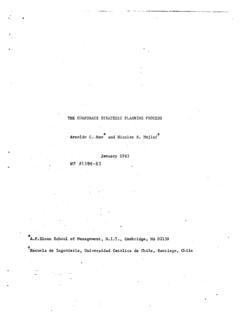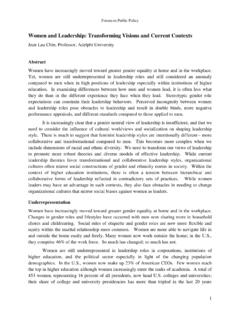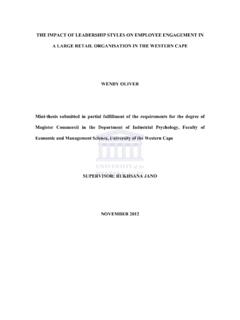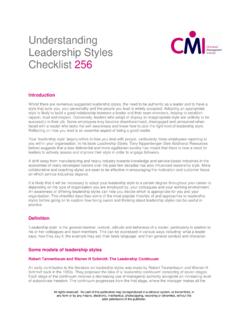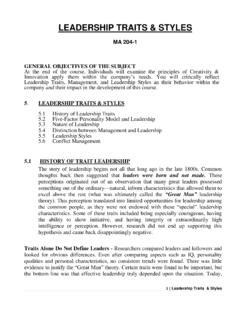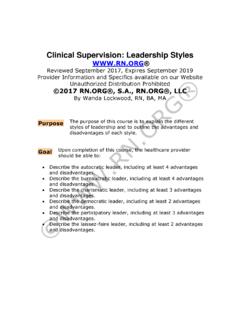Transcription of PRESIDENTS, THEIR STYLES AND THEIR LEADERSHIP
1 PRESIDENTS, THEIR STYLES AND THEIR LEADERSHIP Fred I. GreensteinPrinceton University11220 WORKINGPAPERSCENTERFORPUBLICLEADERSHIPIf one set out to design a democracy in which the personal qualities of the top leader could be expectedto have an impact on political outcomes, the result might well resemble the political system of the UnitedStates. The separation of powers and the Constitutional provision for a president with autonomous pow-ers such as the veto have enabled chief executives to place a personal stamp on the nation's policies sincethe founding of the Republic; but until the1930s, Congress typically took the lead in policy making, andthe activities of the federal government had little impact on the nation and then arose what has come to be called the modern presidency.
2 Under the stimulus of the admin-istrative imperatives of the New Deal and World War II, and the entrepreneurial LEADERSHIP of FranklinD. Roosevelt, there was a dramatic increase in the scope and influence of the federal government and,therefore, its chief executive. The president s capacity to make a difference was further magnified by theemergence of the United States as a world power with a growing arsenal of nuclear weapons. Meanwhile,presidents began increasingly to make policy independent of the legislature, drawing on THEIR sweepingadministrative powers, and the Executive Office of the President was created, providing chief executiveswith the organizational support needed to carry out THEIR expanded question of who occupies the Oval Office is most critical in decisions of war and peace, a domain inwhich the president has the status of commander in chief.
3 There is no more telling illustration of whythe person of the president matters than the Cuban Missile Crisis of October 1962. In that month,President John F. Kennedy and his associates learned that the Soviet Union was secretly installing inCuba a complex of ballistic missiles capable of obliterating much of the United States. This situation,Kennedy concluded, could not be allowed to stand. His advisors were split between those who favoredfinding a nonviolent means of inducing the Soviets to withdraw THEIR missiles and those who called foran immediate air strike on the missile sites, a course of action that we now know would likely have trig-gered a devastating nuclear exchange.
4 The buck stopped with JFK, who decided on the more cautiousoption, even privately acceding to a Soviet demand that the United States withdraw its missiles fromTurkey in exchange for the removal of the Soviet missiles in American president, despite his (and someday, her) life-or-death power in international affairs, is farfrom all-powerful. Presidents are constrained by other forces in the society and political system. Of thepresidents since World War II, Gerald Ford, Jimmy Carter, and George H.
5 W. Bush were defeated at thepolls, Harry S Truman and Lyndon B. Johnson chose not to seek re-election at times when they weredeeply unpopular, Richard M. Nixon resigned, and Kennedy was assassinated. Moreover, even popularchief executives are sometimes blocked or forced to modify THEIR goals by the other powers-that-be in thepolitical system, especially in the domestic sphere. Nevertheless, the personal qualities of the individualwho happens to be president at particular points in American history can have as great an impact as theimpersonal forces and structures that command the bulk of attention in the scholarly literature onAmerican THAT SHAPE PRESIDENTIAL PERFORMANCEHow can the concerned citizen assess the quality of a president s job performance?
6 There are two broadways of doing so. First is asking whether and to what extent the president s policies comport with the cit-izen s own values and convictions. In this fundamentally personal realm, the specialized knowledge ofthe presidential scholar has little to contribute, although valuable insight can be derived from the studyof ethics and political philosophy. Second is evaluating the strengths and weaknesses a president bringsto his responsibilities. Here the presidential specialist canmake a contribution.
7 221In the following paper, I examine the president s performance in terms of six qualities that bear on thejob of the chief first relates to what might be thought of as the outer face of the presiden-tial LEADERSHIP : the president s ability as apublic communicator. The second pertains to its inner face: thepresident s organizational capacity. The third and fourth apply to the president as a political operator: hispolitical skilland the degree to which it is harnessed to a workable policy vision.
8 The fifth and sixth bearon the cognitive stylewith which the president processes the torrent of communications directed to himand the president s emotional intelligence: the matter of whether he is the master of his emotions ratherthan permitting them to intrude into his conduct in office (Goleman, 1995). Effectiveness as a public communicatorThe technology of contemporary mass communication makes the president a constant presence in thenation and world, but for an office that places a premium on the bully pulpit, the presidency has beensurprisingly lacking in accomplished public communicators.
9 The most conspicuous exceptions areFranklin D. Roosevelt, John F. Kennedy, Ronald Reagan. Other presidents who were less consistentlyeffective in THEIR public communications sometimes hit rhetorical home runs: for example, George in the immediate in the aftermath of the terrorist attacks of September 11, 2001, and Bill Clintonwhen he was at his most effective. Chief executives who are daunted by the eloquence of Roosevelt, Kennedy, and Reagan should be relievedto learn that THEIR rhetorical powers were arrived at it by dint of experience and effort they were notinborn.
10 When FDR was a political novice, his wife Eleanor heard him give a speech and was taken abackby his long pauses and slow delivery. I was worried for fear that he would never go on, she recalled(Roosevelt, 1937, 167). When the 29-year-old Kennedy entered the House of Representatives, he was asoft-spoken, halting public speaker; his rhetorical panache evolved in the course of years of collaborationwith his speechwriter and alter ego, Theodore Sorensen. Despite Reagan s extensive experience as a radioannouncer and movie actor, he did not perfect the polished podium manner of his political years untilthe 1950s, when he spent much of the decade on the public speaking circuit as a representative of theGeneral Electric Corporation (Roosevelt, 1937; Silvestri, 2000; Cannon, 1982).




